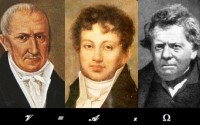Volts, Amps and Ohms: Current affairs in revolutionary Europe
- Date
- 19 Mar 2013
- Start time
- 7:30 PM
- Venue
- Tempest Anderson Hall
- Speaker
- Eur Ing Patrick Mason

Joint lecture with the Institution of Engineering and Technology
Volts, Amps and Ohms: Current affairs in revolutionary Europe
Eur Ing Patrick Mason, Member of The Yorkshire Philosophical Society and Institution of Engineering and Technology
How do you measure electricity? In the 18th century, measurement equipment included pith-balls and frogs legs and there were no established units. Making sense of experiments was a challenge. However, by the early 19th century sense had started to be made of it all and measurement techniques had developed to allow insights into the fundamental laws of electricity. Much of this development is credited to three key scientists: an Italian – Alessandro Volta, a Frenchman – André-Marie Ampere and a German – Georg Simon Ohm. Their names are familiar to us through the units named in their honour. This lecture will follow their work and lives during a period of political turmoil in Europe and explain how we arrived to using Volts, Amps and Ohms.
Download a poster here
Report
These three familiar electric units were named after the scientists, Alessandro Volta, André-Marie Ampère and Georg Simon Ohm. During the eighteenth and nineteenth centuries, a turbulent period of revolution and war, they were prominent among those investigating electricity. Their work took our understanding of the subject from a parlour entertainment to a phenomenon which could be measured, controlled and utilized. In the 1760s, when many thought electricity was of two types, generated respectively by rubbing amber and glass, Volta supported those believing it was a single phenomenon which could flow from one place to another. Later his insight into Galvanis observations on frogs legs inspired him to invent the Voltaic pile, enabling the construction of electric circuits. Ampère quantified the magnetic force between two conductors, and in the 1820s Ohm proposed his famous law linking electric potential, resistance and current. The idea of defining international units of electricity bearing the three names was promoted in 1861 by Lord Kelvin.
Margaret Leonard